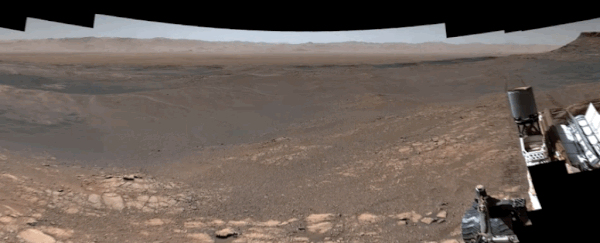When North America celebrated its Thanksgiving holiday last year, a little rover toiling away on Mars took the opportunity to stop and look around. As humans rested, Curiosity was surveying the vast, lonely Martian landscape from its perch on the side of Mount Sharp, and painstakingly taking photographs.
The result is a breathtaking, almost 1.8-billion-pixel panorama stitched together of over 1,000 individual photos, taken over a total of 6.5 hours spread across four days.
Because such panoramas have to be captured within a window of daylight to ensure consistent lighting, it's not often that Curiosity, busy with other tasks, has the time to do this. But holidays are an exception.
"While many on our team were at home enjoying turkey, Curiosity produced this feast for the eyes," said Curiosity project scientist Ashwin Vasavada of NASA's Jet Propulsion Laboratory.
"This is the first time during the mission we've dedicated our operations to a stereo 360-degree panorama."
 (NASA/JPL-Caltech/MSSS)
(NASA/JPL-Caltech/MSSS)
The image shows a region called Glen Torridon - named after the place in Scotland - which the rover had been exploring after descending from the hematite-rich Vera Rubin Ridge in January 2019.
Glen Torridon, by contrast, is rich with clay minerals in layers of sedimentary rock, and is of great interest to planetary geologists. As Curiosity probed the ground beneath its tread, the rover's findings slowly revealed invaluable information about the history of Mars's changing climate.
The drill samples collected by Curiosity confirmed the clay abundances predicted from orbital imaging. More excitingly, wet chemistry on one of the samples turned up organic molecules - not the first found on the Red Planet, but more evidence that there's organic chemistry in the Martian mud.
The region also has helped us to understand the dramatic changes in the Gale Crater, the vast ancient impact basin surrounding Mount Sharp in the centre. Evidence suggests that it was once filled with a salty lake, long ago drained or dried by mechanisms we don't yet fully understand.
Changes in the texture of the sediment of Glen Torridon analysed by Curiosity indicate that there was a change, at some point, in how that sediment was deposited at the bottom of the Gale Crater. By implication, this suggests a change in the environment, from a deep lake to something else.
There are papers in the works about these findings and more - although, sadly, the 51st Lunar and Planetary Science Conference at which many of them were to be presented later this month has been cancelled due to COVID-19. However, we're looking forward to seeing the papers soon.
Right now, Curiosity is making an ambitious climb towards a formation on the lower slopes of Mount Sharp called the Greenheugh pediment. It's hoped that this section can reveal more information about the geologic, geomorphic and climate history of this region of Mars.
In the meantime, if you want to do some Mars exploration of your own, head over to the full resolution image.
